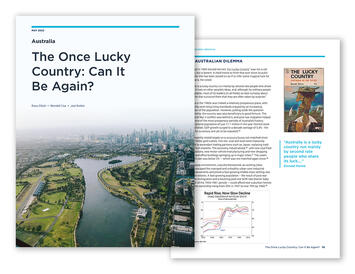
An introduction to this newly released report on demographics and economic mobility in Australia, prepared in collaboration with the Institute of Public Affairs, is excerpted below with a link to the download the full report:
The countries colonized by Britain have served as beacons of opportunity for millions, first from the British Isles, later the rest of Europe, then Asia, Latin America, and Africa.
Although all these countries also share an ugly legacy concerning indigenous people, slaves, convicts, and indentured servants all these societies are rapidly becoming ever more diverse and, despite claims in the media and elsewhere, beacons of opportunity still — now mostly for people in developing countries.
Of course, the past still roils in all these countries, including Australia, where aboriginal people, once dismissed as uncivilized by British officials, are now seeking some indigenous “voice” for themselves. Yet however much historical inequities need to be addresses, it is also evident that the days of “white Australia”, like that of a white America or Canada, are clearly over. In Australia this process began with the opening to southern Europeans after the Second World War and after Vietnam, Asians; a quarter of Australia’s population comes from backgrounds outside Europe.
Far more critical than race are class dynamics that work against the vast majority in these countries, whatever their race or immigration status. The prospects today to achieve the “dream” — Australian or otherwise — have declined inexorably. The chance to buy a home, start a business, to see one’s offspring do better than we are declining, particularly among the middle and working classes, now being marginalized to a level not seen since the dawn of the industrial revolution.
Across the thirty-six wealthier countries of the Organization for Economic Cooperation and Development, the richest citizens have taken an ever greater share of national GDP, and the middle class and “looks increasingly like a boat in rocky waters,” suggests the OECD. Nor is the trend lessening: a recent British parliamentary study, projects that by 2030, the top one percent will expand their share to two thirds of the world’s wealth, with the biggest gains overwhelmingly concentrated at the top .01 percent.
Property As The Key Issue
The class divide reflects changing in the access to property, as it has been since classical times.
If the expansion of European colonialists led to some unspeakable consequences for some, there also rose, at least among Europeans, a substantial class of independent smallholders who demanded a constitutional order that would protect their holdings. As the radical social theorist Barrington Moore said a half century ago, “no bourgeois, no democracy.” Or, to alter Aristotle a bit, no middle class, no political liberty but rule of oligarchia.
A study covering the United Kingdom, the Netherlands, and the United States shows that all three saw a rapid decline in the concentration of wealth from the 1820s up to the 1970s. Never before had so much prosperity and relative economic security been so widely enjoyed. Between 1940 and 1950, the incomes of the bottom 40 percent of American workers surged by roughly 40 percent, while the gains in the top quintile were a modest 8 percent and the top 5 percent saw their incomes drop slightly.
Australia has followed a similar pattern. One recent analysis of long-term trends found that in the immediate post-colonial era, the top 1% of population owned 35% of the country’s wealth. This fell to a low in the 1960s and 1970s as prosperity benefitted the wider working population and an ascendent middle class – such that by then the top 1% controlled only 6% of the wealth. This was perhaps “peak egalitarian” Australia. Since then, the tide has turned decisively in favour of the wealthy, and against the middle and working classes.
To read or download the full report click here.
Ross Elliott is a leading industry practitioner with over 35 years’ experience in property and urban development across a number of industry sectors. He has held senior roles with the Property Council of Australia as Executive Director, National Chief Operating Officer, and National Executive Director of the Residential Development Council. Ross has been a frequent writer and guest speaker on urban development themes both in Australia and the US. In 2018 he published a piece on Australia in a global study of suburban development by the MIT Center for Advanced Urbanism (Cambridge, Mass.) Ross is also founding director of suburban issues think tank Suburban Futures.
Wendell Cox is principal of Demographia (St. Louis, MO-IL). He is a Senior Fellow at the Center for Opportunity Urbanism in Houston, Senior Fellow for Municipal Policy and Housing Affordability at the Frontier Centre for Public Policy in Winnipeg and a member of the Board of Advisors at the Center for Demographics and Policy at Chapman University. He served as a visiting professor at the Conservatoire National des Arts et Metiers in Paris. He was appointed to three terms on the Los Angeles County Transportation Commission by Mayor Tom Bradley and to the Amtrak Reform Council by Speaker of the House Newt Gingrich. He earned a BA in Government from California State University, Los Angeles and an MBA from Pepperdine University, Los Angeles.
Joel Kotkin is the RC Hobbs Presidential Fellow in Urban Futures and author of eleven books, including The City: A Global History, The Human City: Urbanism for the Rest of Us and, most recently, The Rise of Neo-Feudalism: A Warning to the Global Middle Class. He writes a regular column for Quillette, the American Mind, the National Post (Canada) and Spiked. He also writes for Unherd, National Review, the Los Angeles Times, and the Spectator. He has written extensively on issues of class and housing in Europe, North America, and East Asia.












